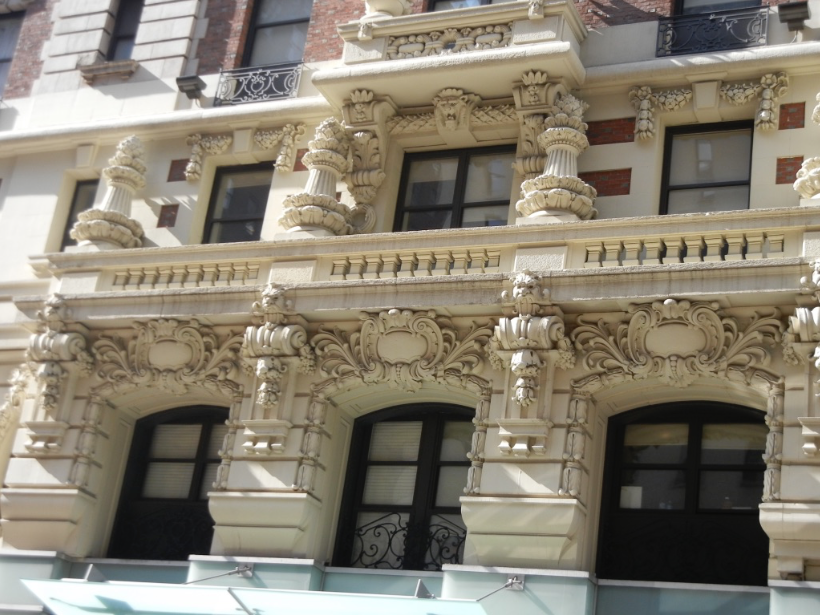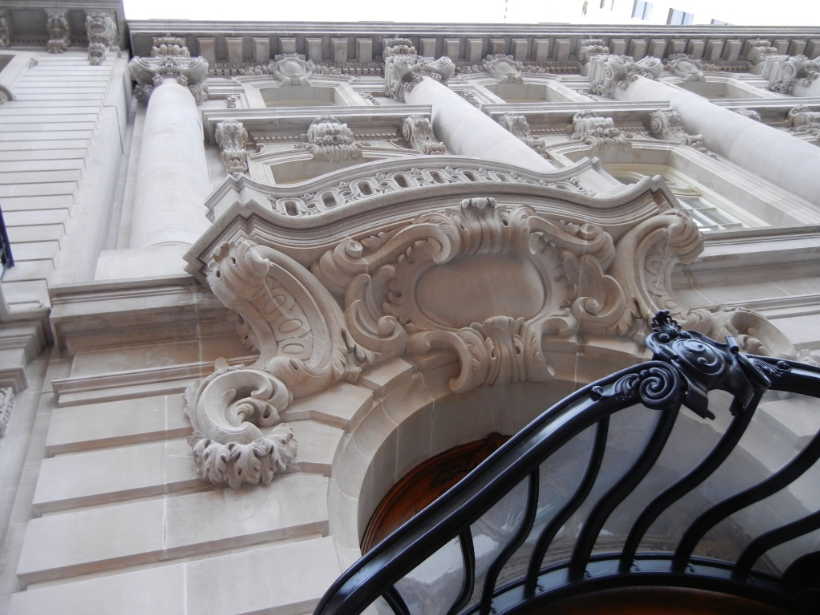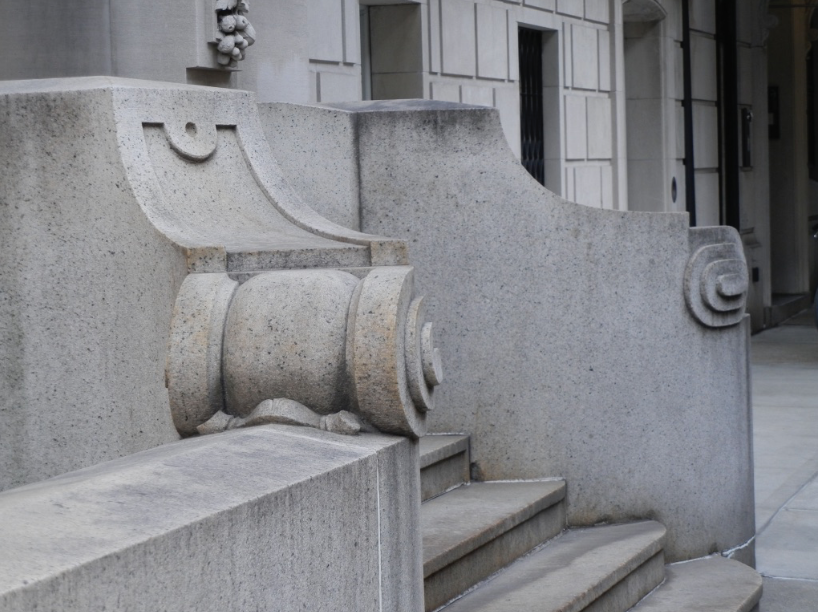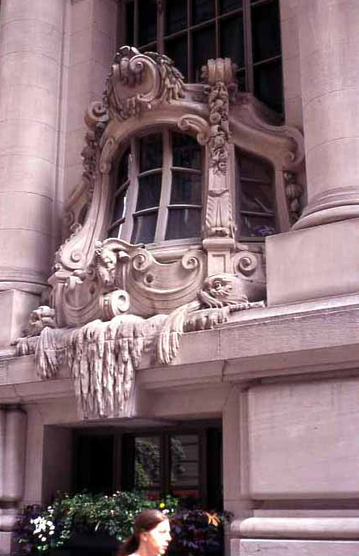
David Brussat
Beautiful Architecture is a Social Good
Taxpayers foot an endless bill for costly social programs intended to improve the lives of the underprivileged. One source of free improvement – a good that is not just free but joyful – is widely ignored by the helping professions. They probably do not even know it exists. It is called beautiful architecture, and, to speak only of where my head is at this morning, it is all over New York City.
Architecture is not free, of course. But it is free to experience once somebody else pays for it. The beautiful paintings and sculpture inside the houses and apartments of the wealthy in Manhattan, which sometimes amount to museums, are not free for all to look at, but the exterior architecture of these places, often including beautiful gardens and statuary, and often of greater value, dollar for dollar, than the stuff inside, is free for anyone to look at.




Anyone walking up and down Fifth Avenue can enjoy the ornamental carving and metalwork that adorn many of its older buildings. You do not need to have a trust account at the Knickerbocker or even a job to qualify to enjoy the nautical facade of the New York Yacht Club at 37 West 44th St., just around the corner from Fifth. Its three ground floor bays express the Baroque stern galleries of old sailing ships, with dolphins cavorting in the waves upon which the vessels seem to float.
Although many blank-faced buildings have arisen here in the past half-century, an astonishing collection of masterpieces remains, along with many more buildings that, in all their relative modesty, put their modern cousins to shame. The latter, speckled all too liberally along the bigger streets, serve to whet the appetite for the remaining abundance of classical grandeur, large and small.
Many buildings erected in the 19th and early 20th centuries line the major avenues of Manhattan and the other boroughs, and the streets of townhouses between them are even better preserved. To stroll their sidewalks is to visit outdoor museums with no admission charge. Statues of grizzled philosophers or nude nymphs are not the only exhibits. Each door is framed in a portico of pillars themselves bedecked with embellishment wrought in a thousand different styles. Each townhouse meets the sidewalk with a balustrade of iron or stone that speaks its own language.
Your ritzier neighborhoods may host relatively more of these treasures on a block-by-block basis, but they remain in every neighborhood, at least in Manhattan. The streets around the Met, the Frick and other landmarks on the Upper East Side are superb settings for those jewels and equally worthy of a visit. For free.
The benefits of beauty need not be recognized or even understood to be enjoyed. A study described in “The Beauty-Happiness Connection,” by Cody Delistraty for The Atlantic, found that seven factors normally considered necessary for happiness – wealth, family, career, friends, health, freedom, values – were less important than civic beauty.
Instead, happiness is most easily attained by living in an aesthetically beautiful city. The things people were constantly surrounded by—lovely architecture, history, green spaces, cobblestone streets—had the greatest effect on their happiness. The cumulative positive effects of daily beauty worked subtly but strongly.
Social scientists should study this phenomenon more closely. Architecture can bring pleasure in ways less direct than the “mere” sight of beauty. As the British philosopher Roger Scruton says in The Classical Vernacular (1995), “The classical idiom does not so much impose unity as make diversity agreeable.” Speaking of a side street in London not unlike many in Manhattan, he adds,
No [town]house obtrudes into the path of the pedestrian, but each meets the pavement with obvious signs of welcome. The windows, crowned by moulded architraves, have that kind of half-smiling look which permits you to glance into them; the flight of steps softens the approach to the door, and provides a useful area of neutral ground between the public and the private.
So it is not just as a museum filled with beautiful objects but as a public space of calm and comfort that enables a street to enchant without the necessity of being overtly enchanting. Pleasure and civic politeness are more than just the sum of buildings and ornament, but rather a way of putting buildings along streets that has been forgotten but which survives in New York and other cities and towns.
Manhattanites are lucky to have so much beautiful architecture. People at every level of income, from near and far, are lucky to be able to visit New York and take advantage of the free stuff. A wise entrepreneur would bottle it and sell it as “something new,” perhaps subsidized by the Department of Health and Human Services.
For 30 years, David Brussat was on the editorial board of The Providence Journal, where he wrote unsigned editorials expressing the newspaper’s opinion on a wide range of topics, plus a weekly column of architecture criticism and commentary on cultural, design and economic development issues locally, nationally and globally. For a quarter of a century he was the only newspaper-based architecture critic in America championing new traditional work and denouncing modernist work. In 2009, he began writing a blog, Architecture Here and There. He was laid off when the Journal was sold in 2014, and his writing continues through his blog, which is now independent. In 2014 he also started a consultancy through which he writes and edits material for some of the architecture world’s most celebrated designers and theorists. In 2015, at the request of History Press, he wrote Lost Providence, which was published in 2017.
Brussat belongs to the Providence Preservation Society, the Rhode Island Historical Society, and the Institute of Classical Architecture & Art, where he is on the board of the New England chapter. He received an Arthur Ross Award from the ICAA in 2002, and he was recently named a Fellow of the Royal Society of the Arts. He was born in Chicago, grew up in the District of Columbia, and lives in Providence with his wife, Victoria, son Billy, and cat Gato.








